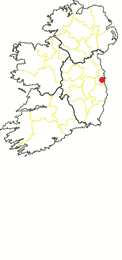
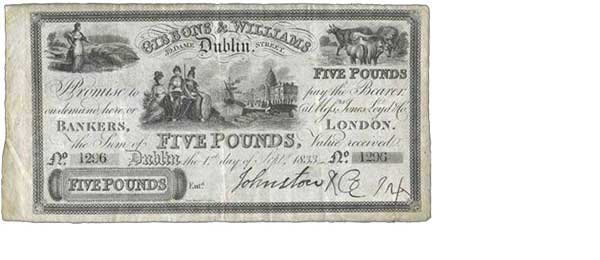
Gibbons and Williams banknotes are unusual for the time in that they were all printed in colour and on both sides, being in black ink on the face and blue ink on the reverse. The notes also had printed dates.
Also notable is the absence on the notes of the partner names apart from reference to the surnames in the Bank Title. At the time the bank commenced business, the law no longer required banks to name all their partners on notes. This was a source of considerable confusion to the public when the Bank failed in 1835.
The bank acted as agents to other private banks, and to the Northern Banking Company [1. Barrow, 1975 p. 108]. In 1833 it began to issue its own notes, and opened a branch in Drogheda. This was very late in the era of note-issuing private banks, at a time when currency issue was very much moving into the realm of the much larger joint stock multibranch banks.
Few other private banks were still issuing notes in this era: Mallow Bank and Ball's Bank being two which had been in business for decades and were taken over by joint stock banks; and Boyle's Bank, a start up in 1832 which was a similar business in nature to Gibbons & Williams and issued notes at least briefly in 1833, it continued in business until being wound up in 1946.
It appears that Hutchins Thomas Williams was the lead partner and the main decision maker in Gibbons & Williams. The Gibbons family had only a minor involvement with one member occupying a junior clerical role [2]. The signature of George Gibbons is seen on some of the issued notes in the entered section, so presumably this is the person in question.
Gibbons and Williams failed in January 1835, with Hutchens Williams going bankrupt.
Banknotes of this bank are common in £1 and 30 Shilling denominations. £5 and £10 denominations are scarce. Along with Ffrench's Bank, its notes are one of the easiest to obtain of the Irish private banks.
The bank did not issue post bills.
One Series of notes known for Gibbons & Williams
There is one series, with two Design Variations for Gibbons and Williams banknotes, and one Type by partnership.
Design 1. Gibbons and Williams 1833 First issue
One date known, 1st July 1833. Four denominations recorded: £1, 30 Shillings, £5, £10.
Design 2. Gibbons and Williams 1833-1834 Modified design
Three dates known. Four denominations recorded: £1, 30 Shillings, £3, £5.
Banknotes of Design 2 are similar to those of Design 1, except that the area of the notes detailing the denomination in words has been modified.
Dates: 1st Sept 1833 (£1, 30 Shillings, £3, £5); 14th Oct 1833 (£1, 30 Shillings, £3); 4th Dec 1834 (30 Shillings, £3).
Denominations recorded: £1, 30 Shillings, £3, £5, £10.
£5 and £10 notes were payable in London in addition to Dublin, the only known case of an Irish private bank's notes being payable in London.
The design around the denomination in words is slightly different on Design 2 notes, as illustrated below. It is likely that £3 notes of Design 1 were printed with the 1st July 1833 date but none have been observed to date.

Series 1, Design 1
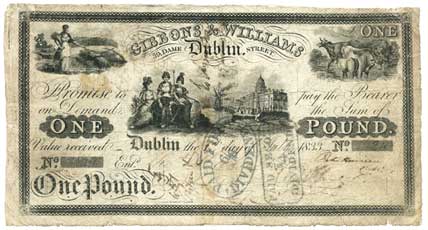
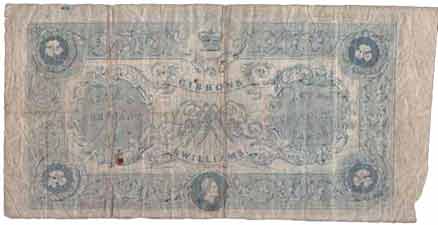
Series 1, Design 2
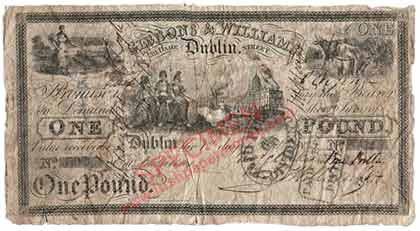
Hutchins Thomas Williams signed most of the issued notes. His signature is seen in two formats: Hutchins T.Williams and H.T.Williams. Examples of the two signature variants are illustrated.


Some of the surviving banknotes give clues as to the possible operations of the bank.
The Five Pound note illustrated below has 'Johnston & Co.' written in the signature area. They acted as agents in London for some of the Irish banks. It is interesting to see that in addition to Dublin, the £5 and £10 notes were payable in London at Jones, Loyd & Co.
The appearance of Johnston & Co. in the signature area is difficult to explain. Could they have actually issued this note?
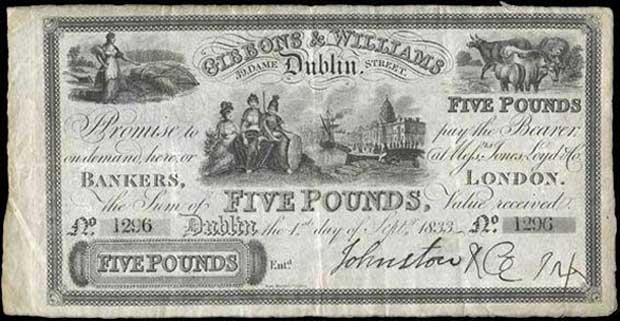
[noonans.co.uk, 14 March 2009, Lot 476]
The stamps on this One Pound note dated 1st September 1833 are interesting. There are two of them stating: ‘PAID FIRST DIVIDEND 6/8’ and ‘PAID SECOND DIVIDEND 3/4’. It looks like two dividends were paid to creditors during the bankruptcy, the first for 6 shillings and 8 pence in the pound, the second for 3 shillings and 4 pence in the pound to make a total of 10 shillings in the pound.
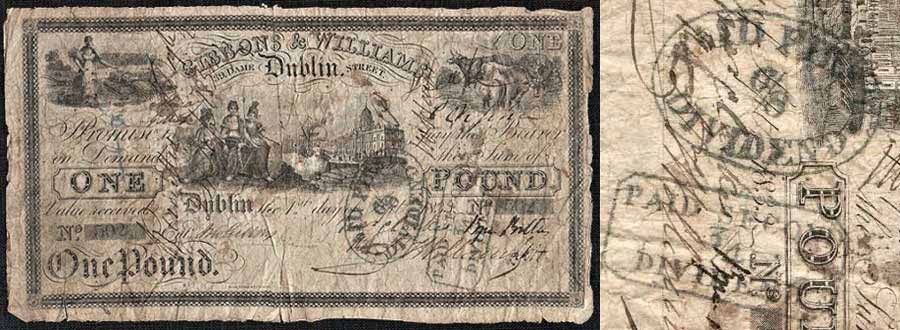
The One Pound note illustrated below appears to have been hand-numbered. This would be the only recorded instance of a Gibbons and Williams note being numbered by hand. The number is indistinct.
This banknote bears a bankruptcy stamp on the reverse, listing the date Nov 3rd 1836, as well as the two payment stamps on the face.
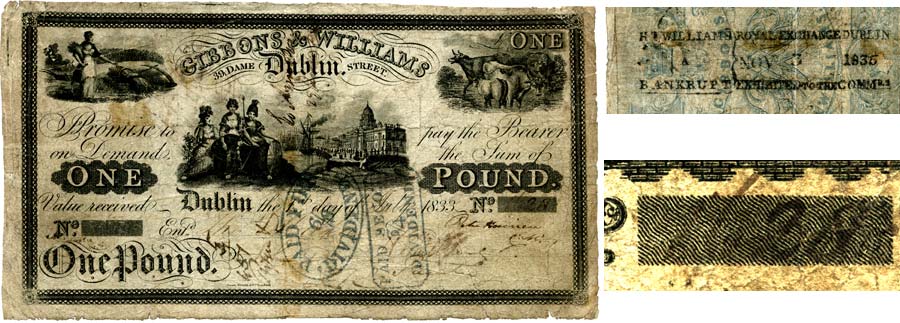
References
1. Barrow, G. L. (1975). The Emergence of the Irish Banking System 1820–1845, Gill & Macmillan.
2. A web resource providing excellent information about the Williams family and those involved in Gibbons & Williams' Bank.
3. Auction Catalogue, Noonan's (DNW), London. Important Collection of Irish Paper Money formed by Bob Blake (Part II), Noonan's (DNW), 14 March 2009.